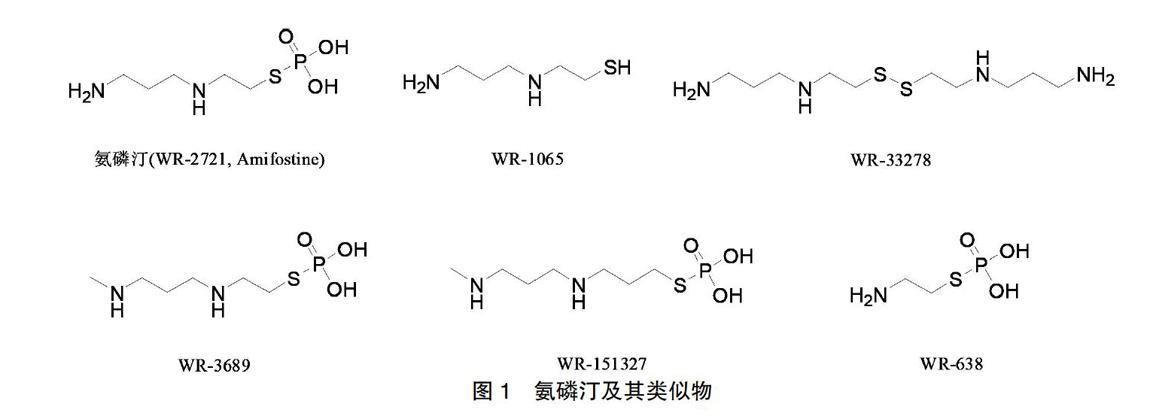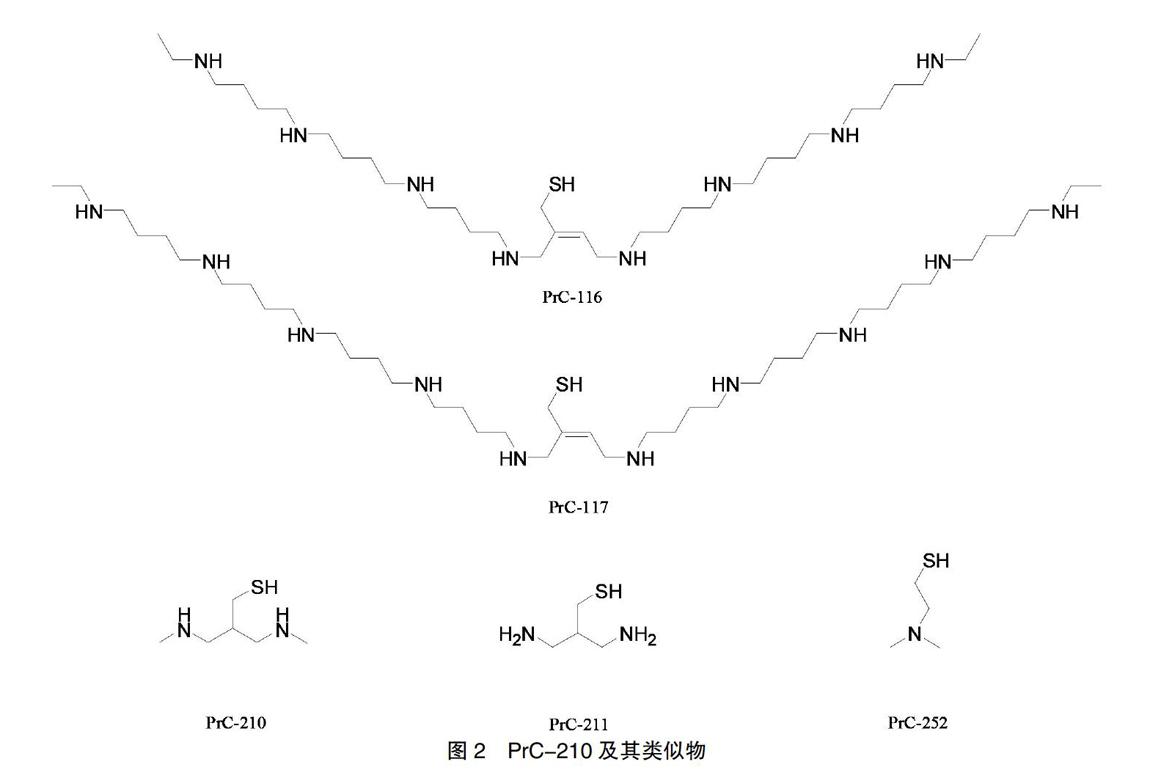氨基硫醇类辐射防护剂的研究进展
2019-09-07李雪娇田红旗
李雪娇 田红旗



[摘要] 随着核技术的发展,人们受到电离辐射的风险日益增加。氨基硫醇类化合物作为第一代辐射防护剂,可通过清除电离辐射产生的自由基等机制减少电离辐射对机体的损伤。其代表性化合物氨磷汀是目前唯一被FDA批准应用于临床的小分子辐射防护剂,其药效高但具有低血压等副作用。PrC-210是新型的氨基硫醇类辐射防护剂,具有副作用小、药效高的特点。通过控制分子骨架氨基数量和分子量、对分子中的巯基进行修饰等手段可获得更优的氨基硫醇类辐射防护剂。
[关键词] 电离辐射;辐射损伤;辐射防护剂;氨基硫醇;自由基
[中图分类号] R142 [文献标识码] A [文章编号] 1673-7210(2019)06(a)-0042-04
Research progress in radioprotectors from the family of aminothiols
LI Xuejiao TIAN Hongqi
Institute of Radiation Medicine, Chinese Academy of Medical Sciences and Peking Union Medical College, Tianjin Key Laboratory of Radiation Medicine and Molecular Nuclear Medicine, Tianjin 300192, China
[Abstract] With the development of nuclear technique, the threat of radiation exposure is increasing. As the first generation of radioprotectors, aminothiols can scavenge free radicals formed from ionizing radiation so that they can protect normal tissue from the harmful effects of ionizing radiation. Amifostine is the representative compound among aminothiols and the only small molecular radioprotective agent approved by FDA in clinical application at present, it has good radioprotective effects but many side effects such as hypotension. PrC-210 is a new aminothiol radioprotector, it has few side effects and high radioprotective efficacy. A better aminothiol radioprotectors can be obtained by controlling the number of amino groups in the molecular backbone and molecular weight, and modifying the sulfhydryl group in the molecule.
[Key words] Ionizing radiation; Radiation damage; Radioprotectors; Aminothiols; Free radicals
随着核技术的迅速发展,人们接触电离辐射的可能性日益增加,我们需要找到一种有效的辐射防护剂来减轻电离辐射对人体的损害[1]。国内外学者[2-4]开发了很多辐射防护剂,包括氨基硫醇类辐射防护剂、天然抗氧化剂、激素类辐射防护剂等。其中氨基硫醇类化合物可快速提高细胞对电离辐射的抵抗能力,抵御更高剂量的辐射,因此具有独特的优势。氨基硫醇类辐射防护剂包括半胱氨酸、半胱胺、氨磷汀(WR-2721,Amifostine)、WR-3689、WR-151327、WR-638、β-氨基乙基异硫脲(β-aminoethylisothiuronium,AET)、N-乙酰半胱氨酸(N-acetyl-L-cysteine,NAC)、N-2-巯基丙酰基甘氨酸(N-2-mercaptopropionylglycine,MPG)、二乙基二硫代氨基甲酸酯(diethyldithiocarbamate,DDC)、2,2-二甲基噻唑烷、PrC-210等[5-7]。本文對现有氨基硫醇类辐射防护剂的药效、毒性和辐射防护机制进行了综述,并对此类辐射防护剂的未来发展方向进行了展望,旨在为其进一步研究提供思路。
1 氨基硫醇类辐射防护剂
1.1 氨磷汀及其类似物
氨磷汀是目前最有效的辐射防护剂,已被美国食品药品监督管理局(FDA)批准应用于临床。它是一种线性五碳烷基胺,含有两个氨基和一个被磷酸基团修饰的末端巯基(图1)。氨磷汀经血液循环到达组织细胞表面时,可以被迅速地去磷酸化,形成其活性代谢物WR-1065。在低pH环境中,氨磷汀的去磷酸化主要依赖于水解作用;而在相对高pH环境中,氨磷汀的去磷酸化则主要依赖于碱性磷酸酶的作用[8]。因此,肿瘤组织与正常组织碱性磷酸酶浓度和pH值的差异可造成这两种组织间WR-1065浓度的差异。WR-1065进入细胞后,可清除氧自由基;同时,WR-1065可提高细胞内p53蛋白的水平,导致p53调控基因如p21基因等表达的上调。此外,WR-1065可在细胞内形成二硫化物WR-33278。据报道[9],WR-1065与WR-33278都可以直接与核转录因子κB(NF-κB)结合并使其激活,从而增强细胞内含锰超氧化物歧化酶(Mn-SOD)的表达。目前,氨磷汀已被应用于减轻接受放疗或化疗的某些肿瘤(包括头颈部肿瘤、肺癌、乳腺癌、肝癌等)患者的正常组织损伤[10]。
作为一种辐射防护剂,氨磷汀在临床应用上具有以下优势:①氨磷汀可在不影响电离辐射对肿瘤杀伤作用的前提下保护正常组织细胞。②氨磷汀具有广谱辐射防护特性[11]。然而,在某些情况下,氨磷汀的临床使用也会受到限制,原因包括:①药物作用时间短;②只能通过静脉注射的方式给药;③氨磷汀具有较多副作用,包括:恶心、呕吐、低血压、昏厥、发热、寒战、过敏反应、短暂性低钙血症等;④氨磷汀难以跨越血脑屏障,对中枢神经系统的保护作用较小[12]。
氨磷汀的类似物,包括WR-3689、WR-151327和WR-638等,也具有良好的辐射防护性能(图1)。其中,WR-151327口服给药毒性明显小于氨磷汀,然而其必须给予较大剂量才能產生相同水平的辐射防护作用,故其仍然无法作为有效的口服辐射防护剂[13]。
1.2 PrC-210及其类似物
近年来,研究者合成出了一类新型的氨基硫醇类化合物,其代表化合物为PrC-210,它的结构特征包括:①分子量小;②主链短而灵活,为有两个氨基的烷基链;③侧链末端巯基与主链及DNA分子相距较远。PrC-210分子量较小,这利于它的跨膜扩散。PrC-210分子中的巯基远离DNA分子,可以使自由基在攻击DNA分子前就被清除。PrC-210可抑制人成纤维细胞的生长,在照射前,局部应用PrC-210可预防2~3级放射性皮炎[14]。更重要的是,Peebles等[15]研究发现,在异种移植瘤上的皮肤局部应用PrC-210不会影响电离辐射对肿瘤细胞的损伤。作为一种新型的辐射防护剂,PrC-210具有如下优势:①PrC-210局部应用于皮肤,对放射性皮炎有很好的预防效果。②PrC-210口服应用效果良好,便于临床使用。③药物作用时间较长。④PrC-210应用于全身时,没有引起任何副作用,包括恶心、呕吐、低血压、昏厥等[16]。
PrC-100系列化合物辐射防护效果较差,这可能是因为分子骨架中氨基的增加可以增强氨基硫醇分子与DNA分子间的离子相互作用,从而导致正常细胞的生长抑制[17]。PrC-200系列化合物为含有1~2个氨基和1个巯基的4~6碳氨基硫醇分子,其巯基位于垂直的烷基侧链末端。在这一系列化合物中,除PrC-210外,PrC-211和PrC-252也具有较高的辐射防护活性(图2)。其中,PrC-252是最小的分子,而PrC-210是最有效的辐射防护剂。研究[18]表明,在照射前,局部应用PrC-211也可以预防2~3级放射性皮炎,但PrC-211分子烷基胺骨架上裸露的末端氨基容易被乙酰化,而PrC-210分子具有相对稳定的结构,因此PrC-210辐射防护效果更好。
1.3 其他氨基硫醇类化合物
除了氨磷汀、PrC-210及它们的类似物,还有很多氨基硫醇类化合物可作为辐射防护剂,包括β-氨基乙基异硫脲(AET)、N-乙酰半胱氨酸(NAC)、N-2-巯基丙酰基甘氨酸(MPG)、二乙基二硫代氨基甲酸酯(DDC)、2,2-二甲基噻唑烷等(图3)。AET是一种有效的辐射防护剂,它在中性或碱性的条件下可发生分子重排,形成其活性产物巯基乙胍(mercaptoethylguanidine,MEG),研究证明AET能够降低受γ射线照射小鼠骨髓细胞的微核率[19]。NAC能够促进细胞内还原型谷胱甘肽(GSH)的生物合成[20]。据报道[21],在照射前使用NAC可使双链DNA断裂(double strand breaks,DSBs)降低43%。MPG是一种含游离巯基的甘氨酸衍生物,可减轻电离辐射对淋巴细胞染色体的损伤;DDC是双硫仑代谢物,可作为抗氧化酶活性调节剂;2,2-二甲基噻唑烷是半胱胺的前药,进入体内可逐渐释放出半胱胺,发挥辐射防护作用[22]。相较于氨磷汀,AET、NAC、MPG、DDC、2,2-二甲基噻唑烷这五种化合物的剂量减低系数(dose-reduction factor,DRF)值较低,但副作用较少[23]。
2 氨基硫醇类化合物的辐射防护机制
氨基硫醇类化合物的辐射防护机制主要包括以下几个方面:①其基本化学结构为含有氨基和巯基或经修饰的巯基的灵活烷基链。氨基的存在使这类分子带正电荷,可以与带负电荷的DNA分子通过静电吸引方式发生紧密的相互作用;巯基的存在使此种化合物可以清除电离辐射作用下产生的氧自由基[24]。②其直接与生物大分子辐解产物发生相互作用,巯基上的氢原子可以转移到生物大分子自由基上,从而导致生物大分子的化学修复:М·+RSH→MH+RS·[24]。③RS·可通过重组形成二硫化物RS-SR,因而易于衰减,以此来保持机体内部环境的相对稳定[25]。④氨基硫醇类化合物可提高细胞内GSH的水平[26]。⑤在氨基硫醇化合物的作用下,DNA分子的构象可发生变化,从而促进一些转录因子(包括NF-κB、p53蛋白等)与其发生相互作用。NF-κB的激活可以促进Mn-SOD的表达;p53蛋白的激活可以上调p21基因等的表达,从而将细胞阻滞在G1期,为电离辐射诱导的DNA损伤的修复提供有利条件[26]。
3 讨论与展望
现有的氨基硫醇类化合物中,氨磷汀是唯一被FDA批准应用于临床的辐射防护剂。然而,氨磷汀只能通过静脉注射的方式给药,且作用时间短,副作用较多,其临床应用受到了极大限制。AET、NAC、MPG、DDC、2,2-二甲基噻唑烷等氨基硫醇类化合物虽然不良反应较少,但它们的DRF值均低于氨磷汀,因此其辐射防护性能仍有待提高。PrC-200系列氨基硫醇类化合物可作为有效的辐射防护剂,其代表化合物PrC-210作用时间较长、副作用较少,既可以口服应用显示出全身辐射防护活性,也可以局部应用以预防放射性皮炎。
通过对现有氨基硫醇类辐射防护剂的优势和局限性进行分析,认为设计新型的氨基硫醇类辐射防护剂可考虑以下几个方面:①分子中过量的氨基会导致细胞生长抑制,因此分子骨架中的氨基基团不宜过多;②分子骨架上的末端氨基不稳定,容易被乙酰化,因此分子中裸露的末端氨基应尽可能少;③为了提高口服吸收率,设计的化合物分子量不宜过大,使其更易于跨膜扩散;④为增加分子脂溶性、提高其稳定性、降低毒性,可用保护基团对分子中的巯基进行修饰。总之,氨基硫醇类化合物仍然具有广阔的发展前景,值得进一步研究。
[参考文献]
[1] Singh VK,Seed TM. A review of radiation countermeasures focusing on injury-specific medicinals and regulatory approval status:part I. Radiation subsyndromes,animal models and FDA-approved countermeasures [J]. Int J Radiat Biol,2017,93(9):851-869.
[2] Kleiman NJ,Stewart FA,Hall EJ. Modifiers of radiation effects in the eye [J]. Life Sci Space Res,2017,15:43-54.
[3] Jafari E,Alavi M,Zal F. The evaluation of protective and mitigating effects of vitamin C against side effects induced by radioiodine therapy [J]. Radiat Environ Biophys,2018, 57(3):233-240.
[4] 張俊伶,路璐,李德冠,等.四种雌激素对放射性造血损伤防护效应的比较[J].中国医药导报,2015,12(10):4-6,17.
[5] Crowe ME,Lieven CJ,Thompson AF,et al. Borane-protected phosphines are redox-active radioprotective agents for endothelial cells [J]. Redox Biol,2015,6:73-79.
[6] Vasin MV,Ushakov IB,Antipov VV. Potential role of catecholamine response to acute hypoxia in the modification of the effects of radioprotectors [J]. Bull Exp Biol Med,2015,159(5):597-600.
[7] Vasin MV,Ushakov IB,Kovtun VY,et al. Pharmacological analysis of the therapeutic effect of radioprotectors cystamine and indralin in the capacity of radiomitigators [J]. Bull Exp Biol Med,2017,162(4):466-469.
[8] Feng M,Smith DE,Normolle DP,et al. A phase I clinical and pharmacology study using amifostine as a radioprotector in dose-escalated whole liver radiation therapy [J]. Int J Radiat Oncol Biol Phys,2012,83(5):1441-1447.
[9] Liu W,Chen Q,Wu S,et al. Radioprotector WR-2721 and mitigating peptidoglycan synergistically promote mouse survival through the amelioration of intestinal and bone marrow damage [J]. J Radiat Res,2015,56(2):278-286.
[10] Rajan Radha R,Chandrasekharan G. Pulmonary injury associated with radiation therapy-Assessment,complications and therapeutic targets [J]. Biomed Pharmacother,2017,89:1092-1104.
[11] Koseva N,Tsacheva I,Mitova V,et al. Polymer complex of WR 2721. Synthesis and radioprotective efficiency [J]. Eur J Pharm Sci,2014,65:9-14.
[12] Rahgoshai S,Mohammadi M,Refahi S,et al. Protective effects of IMOD and cimetidine against radiation-induced cellular damage [J]. J Biomed Phys Eng,2018,8(1):133-140.
[13] Weiss JF. Pharmacologic approaches to protection against radiation-induced lethality and other damage [J]. Environ Health Perspect,1997,105(S6):1473-1478.
[14] Kamran MZ,Ranjan A,Kaur N,et al. Radioprotective agents:strategies and translational advances [J]. Med Res Rev,2016,36(3):461-493.
[15] Peebles DD,Soref CM,Copp RR,et al. ROS-scavenger and radioprotective efficacy of the new PrC-210 aminothiol [J]. Radiat Res,2012,178(1):57-68.
[16] Soref CM,Hacker TA,Fahl WE. A new orally active,aminothiol radioprotector-free of nausea and hypotension side effects at its highest radioprotective doses [J]. Int J Radiat Oncol Biol Phys,2012,82(5):e701-e707.
[17] Copp RR,Peebles DD,Fahl WE. Synthesis and growth regulatory activity of a prototype member of a new family of aminothiol radioprotectors [J]. Bioorg Med Chem Lett,2011,21(24):7426-7430.
[18] Copp RR,Peebles DD,Soref CM,et al. Radioprotective efficacy and toxicity of a new family of aminothiol analogs [J]. Int J Radiat Biol,2013,89(7):485-492.
[19] Patyar RR,Patyar S. Role of drugs in the prevention and amelioration of radiation induced toxic effects [J]. Eur J Pharmacol,2018,819:207-216.
[20] Rushworth GF,Megson IL. Existing and potential therapeutic uses for N-acetylcysteine:the need for conversion to intracellular glutathione for antioxidant benefits [J]. Pharmacol Ther,2014,141(2):150-159.
[21] Kim JK,Park J,Ryu TH,et al. Effect of N-acetyl-L-cysteine on Saccharomyces cerevisiae irradiated with gamma-rays [J]. Chemosphere,2013,92(5):512-516.
[22] Smith TA,Kirkpatrick DR,Smith S,et al. Radioprotective agents to prevent cellular damage due to ionizing radiation [J]. J Transl Med,2017,15(1):232-249.
[23] Citrin D,Cotrim AP,Hyodo F,et al. Radioprotectors and mitigators of radiation-induced normal tissue injury [J]. Oncologist,2010,15(4):360-371.
[24] Vasin MV. Comments on the mechanisms of action of radiation protective agents:basis components and their polyvalence [J]. Springer Plus,2014,3:414.
[25] Maier P,Wenz F,Herskind C. Radioprotection of normal tissue cells [J]. Strahlenther Onkol,2014,190(8):745-752.
[26] Kim W,Kang J,Lee S,et al. Effects of traditional oriental medicines as anti-cytotoxic agents in radiotherapy [J]. Oncol Lett,2017,13(6):4593-4601.
(收稿日期:2018-12-03 本文編辑:王 蕾)
